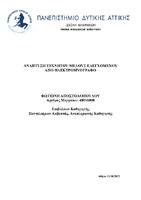| dc.contributor.advisor | Asvestas, Pantelis | |
| dc.contributor.author | Αποστολοπούλου, Φωτεινή | |
| dc.date.accessioned | 2022-10-13T13:17:38Z | |
| dc.date.available | 2022-10-13T13:17:38Z | |
| dc.date.issued | 2022-10-11 | |
| dc.identifier.uri | https://polynoe.lib.uniwa.gr/xmlui/handle/11400/3073 | |
| dc.identifier.uri | http://dx.doi.org/10.26265/polynoe-2913 | |
| dc.description.abstract | Η παρούσα διπλωματική εργασία συντέλεσε μέρος της ολοκλήρωσης των προπτυχιακών σπουδών για το τμήμα Μηχανικών Βιοϊατρικής του Πανεπιστημίου Δυτικής Αττικής. Στόχος ήταν η κατασκευή ενός προσθετικού μέλους το οποίο θα κινούταν από έναν ηλεκτρομυογράφο.
Η ανάγκη των ανθρώπων για τη δημιουργία τεχνητών μελών έκανε την πρώτη της εμφάνιση χιλιετίες πριν και από τότε δεν έχουν σταματήσει να δημιουργούνται νέες καινοτομίες. Η χρήση τους, δίνει τη δυνατότητα στα άτομα που τα χρειάζονται να βελτιώσουν την ποιότητα ζωής τους και να είναι πιο ανεξάρτητα.
Στην προκείμενη διπλωματική, πρώτα κατασκευάστηκαν τα κομμάτια του τεχνητού μέλους με τη χρήση της τεχνικής της τρισδιάστατής εκτύπωσης. Αφότου συναρμολογήθηκαν τα εκτυπωμένα κομμάτια, τοποθετήθηκαν οι σερβοκινητήρες στο εσωτερικό του μέλους. Στη συνέχεια, ακολούθησε η απαραίτητη συνδεσμολογία των σερβοκινητήρων με το τροφοδοτικό τους, το breadboard, το Arduino Uno και τον
ηλεκτρομυογράφο myoware. Ο ηλεκτρομυογράφος έλαβε το σήμα από τους μύες του χειριστή μέσω επιφανειακών ηλεκτροδίων. Ύστερα, το σήμα αυτό προωθήθηκε στο Arduino Uno που με τον κατάλληλό προγραμματισμό έδινε την εντολή στα δάχτυλα είτε να κλείσουν, είτε να ανοίξουν αναλόγως με το αν ο χειριστής «σφίγγει» ή «χαλαρώνει» τους μύες του.
Μετά την ολοκλήρωση της κατασκευής του τεχνητού μέλους και της συνδεσμολογίας του, έγινε έλεγχος επιβεβαίωσης για τον αν λειτουργεί με τον επιθυμητό τρόπο. Καθώς και για το αν διαθέτει τη δυνατότητα συγκράτησης αντικειμένων. Τέλος, έγινε λόγος για πιθανή μελλοντική βελτίωση του προσθετικού άκρου με την προσθήκη επιπλέον ηλεκτρομυογράφων. | el |
| dc.format.extent | 65 | el |
| dc.language.iso | el | el |
| dc.publisher | Πανεπιστήμιο Δυτικής Αττικής | el |
| dc.rights | Αναφορά Δημιουργού - Μη Εμπορική Χρήση - Παρόμοια Διανομή 4.0 Διεθνές | * |
| dc.rights | Attribution-NonCommercial-NoDerivatives 4.0 Διεθνές | * |
| dc.rights.uri | http://creativecommons.org/licenses/by-nc-nd/4.0/ | * |
| dc.subject | Τεχνητό μέλος | el |
| dc.subject | Ηλεκτρομυογράφος | el |
| dc.subject | Σερβοκινητήρες | el |
| dc.subject | Τρισδιάστατη εκτύπωση | el |
| dc.subject | Ηλεκτρόδια | el |
| dc.subject | Arduino uno | el |
| dc.subject | Myoware | el |
| dc.title | Ανάπτυξη τεχνητού μέλους ελεγχόμενου απο ηλεκτρομυογράφο | el |
| dc.title.alternative | Development of an artificial limb controlled by an electromyograph | el |
| dc.type | Διπλωματική εργασία | el |
| dc.contributor.committee | Kostopoulos, Spiros | |
| dc.contributor.committee | Glotsos, Dimitris | |
| dc.contributor.faculty | Σχολή Μηχανικών | el |
| dc.contributor.department | Τμήμα Μηχανικών Βιοϊατρικής | el |
| dc.description.abstracttranslated | This thesis was part of the completion of the undergraduate studies for the Department of Biomedical Engineering of the University of West Attica. The aim was to construct a prosthetic limb that would be powered by an electromyograph.
The need of humans to create artificial limbs made its first appearance millennia ago and since then new innovations have not ceased to be created. Their use enables people in need of them, to improve their quality of life and be more independent.
In the present thesis, the artificial limb pieces were first manufactured using the technique of 3D printing. After the printed pieces were assembled, the servo motors were placed inside the limb. Then followed the wiring of the servomotors with their power supply, the breadboard, the Arduino Uno and the myoware electromyograph. The electromyograph received the signal from the operator's muscles via surface electrodes. Then, this signal was forwarded to the Arduino Uno which, with the proper programming, commanded the fingers to either close or open depending on whether the operator "tightens" or "relaxes" his muscles.
After the construction of the artificial limb and its connection was completed, a confirmation check was made on whether it works as intended. As well as whether it has the ability to hold objects. Finally, possible future improvement of the prosthetic limb with the addition of additional electromyographs was discussed. | el |



